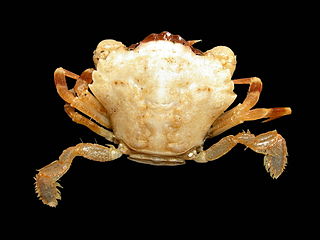
Libinia emarginata, the portly spider crab, common spider crab or nine-spined spider crab, is a species of stenohaline crab that lives on the Atlantic coast of North America.

The Japanese spider crab is a species of marine crab that lives in the waters around Japan. It has the largest leg span of any arthropod. They go through three main larval stages along with a prezoeal stage in order to grow to their great size. The genus Macrocheira contains multiple species. Two fossil species of this genus have been found, Macrocheira ginzanensis and Macrocheira yabei, both from the Miocene of Japan. The diverse taxonomic history is an important part of what these creatures are and how they evolved to be what they are today. These creatures are not isolated however, as they are the subject of fishery and are considered a delicacy. Conservation efforts are being put forth to protect these creatures and their population from the dangers of overfishing.

Cancer pagurus, commonly known as the edible crab or brown crab, is a species of crab found in the North Sea, North Atlantic Ocean, and perhaps the Mediterranean Sea. It is a robust crab of a reddish-brown colour, having an oval carapace with a characteristic "pie crust" edge and black tips to the claws. A mature adult may have a carapace width up to 25 cm (10 in) and weigh up to 3 kg (6.6 lb). C. pagurus is a nocturnal predator, targeting a range of molluscs and crustaceans. It is the subject of the largest crab fishery in Western Europe, centred on the coasts of the British Isles, with more than 60,000 tonnes caught annually.

The Tasmanian giant crab, Pseudocarcinus gigas is a very large species of crab that resides on rocky and muddy bottoms in the oceans off Southern Australia. It is the only species in the genus Pseudocarcinus.

Carcinus is a genus of crabs, which includes Carcinus maenas, an important invasive species, and C. aestuarii, a species endemic to the Mediterranean Sea.

Portunus trituberculatus, the gazami crab, South Korea's blue crab or horse crab, is the most widely fished species of crab in the world. It is found off the coasts of East Asia and is closely related to Portunus armatus.

The red rock crab, Guinusia chabrus, is a marine large-eyed crab of the family Plagusiidae. It is found in the southern Indian and southern Pacific Oceans, including South Africa, Australia, New Zealand, and Chile.

Maja is a genus of majid crabs erected by Jean-Baptiste Lamarck in 1801. It includes the following extant species:

Ranina ranina, also known as the (red) frog crab or spanner crab, is a species of crab found throughout tropical and subtropical habitats. It is often fished for its meat, and is the only known species in its genus.

Mithrax spinosissimus, also known as the West Indian spider crab, channel clinging crab, reef or spiny spider crab, or coral crab, is a species of spider crab that occurs throughout South Florida and across the Caribbean Islands. The diet of this crab is largely unknown; however, it is considered a large omnivore, reaching size up to 2 kg, which has been noted to feed on algae and carrion. Unlike crabs such as the blue crab, the West Indian spider crab is not commercially harvested for its meat, though it is said to be delicious.

Amarinus lacustris is a species of freshwater crab from Australia, New Zealand and nearby islands, where it lives in water of various salinities. It grows up to 10 mm (0.4 in) wide, with an H-shaped groove on its back. It is an omnivore and is eaten by crayfish and fish. It was first discovered in Lake Pupuke, near Auckland, and is the only freshwater crab in New Zealand.

Achaeopsis spinulosa, the hotlips spider crab, is a species of crab in the family Inachidae, found only around the South African coast. It is the only species in the genus Achaeopsis.

Acanthonyx dentatus, the toothed decorator crab, is a species of crab in the family Inachidae.

Liocarcinus navigator is a species of crab in the family Portunidae.

Liocarcinus pusillus, common name dwarf swimming crab, is a species of crab in the Portunidae family.
Homola barbata is a species of crab in the family Homolidae.

Pugettia gracilis, commonly known as the graceful kelp crab, is a species of small crab in the family Epialtidae. It lives among forests of kelp on the Pacific coast of North America.

Libinia dubia, the longnose spider crab, is a species of crab in the family Epialtidae. It is found in shallow waters on the eastern coast of North America.
Libinia ferreirae is a species of tropical spider crab in the family Epialtidae. It is found on the seabed in shallow waters off the Atlantic coast of South America.

Macropodia rostrata, common names, the common spider crab, long-legged spider crab, long-legged crab, is a species of marine crab in the family Inachidae. The Macropodia Rostrata visually mimics many other types of small crabs with the exception of its long legs. By attaching algae to their thin legs, they can be confused with the stem of seaweed. This is both a defense mechanism and a predatory advantage, as unsuspecting fish will hide in seaweed beds from nearby predators. This behavior can be absent among larger crabs, and those that live at great depths like giant Japanese spider crabs.

















